Events of Friday 1st May 2015
In the afternoon, Aung and I travelled together on Air Bagan Flight W9-424 from Putao to Mandalay with an intermediate stop at Myitkyina. At Mandalay, I disembarked whilst Aung stayed on the flight to return to his home in Yangon. The transfer bus at Mandalay was a very second hand Japanese bus. In the large baggage hall, we waiting some minutes before one on the baggage conveyors started up and started spitting out bags intermittently. I stood despondently as the waiting crowd thinned out having found their bags until I was alone and no more bags emerged. Then, a member of staff came sauntering up pushing my bag which, for some reason, had not been through the baggage conveyor. Once they'd collected my baggage tag, I was able to have all my luggage X-rayed and move into the arrivals hall where I'd spotted my waiting driver. He recognised me and said he'd driven me before. He was driving an air-conditioned Toyota 'Alphard' and, for once, I didn't complain about the air conditioning.
Myanmar is changing quite quickly in some respects. The dual carriageway leading away from the airport has sprouted regular posts which I assume will shortly be fitted with lights. At one of the many traffic islands, a huge filling station is under construction. At one point, extensive blocks of what looked like apartments are being built. At the junction with the road to Sagaing, we took the right fork for Mandalay but, in the background, I could see the silhouette of the Sagaing Hills with the triple arches of the new road bridge. As we approached the city, we passed a toll station which relieved us of 500 kyat (about half a U.S. Dollar) after which are area became built up with commercial and industrial premises lining the dual carriageway. As we came nearer, the traffic sloowed, giving me time to notice large new cantilevered structures carrying traffic lights. I noticed the rather mis-named Prince Airport Hotel - it had taken us 30 minutes from the airport to pass the hotel. As we continued, the shops seemed to be more up-market fashion stores and lots of mobile phone stores. Having passed the railway station, we turned right to run parallel to part of the moat around the former royal palace. Very soon, we were pulling into the forecourt of the Sedona Hotel.
Fortunately, I was expected so, within a few minutes, I was in a comfortable room at the front on the 5th floor, with a splendid view along the palace moat to Mandalay Hill in the background. Rooms at the front are noisier, but I think I prefer the front for the commanding views. I'm at the Sedona for two nights, then I fly back to Yangon for the last segment of my trip before returning to England.
I'm afraid there's been too much going on to write up all that's happened but, sooner or later (probably later) I'll try to complete the story and add pictures.
All my posts on this trip to Myanmar can be found here.
Friday, 1 May 2015
Putao (Part 2)
Events of Wednesday 29th April 2015
We’d arranged to explore the Market at around 7 o’clock in the morning.
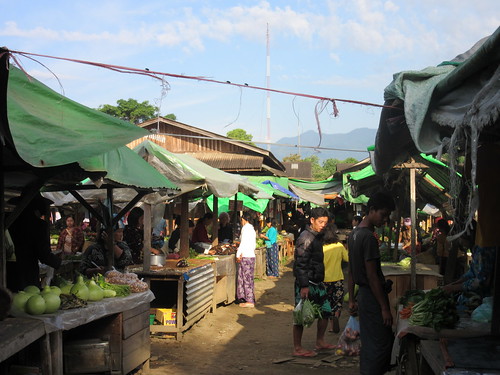 Putao Market.
Putao Market.
With appetites whetted by the walk, we returned to Putao Trekking House for breakfast. They’d laid on white toast with butter and preserves followed by a plain omelette for me. They couldn’t resist following that with a pancake and honey. I have to admit, the pancake was very good.
After breakfast, we set off on the main feature of the day – a trek of around ten miles to Namkhan Village. I’d loaded my backpack with clothes and essentials for one night’s stay at a guest house at our destination. We initially set off in the Toyota – Aung, the Local Guide, the driver and two young men who travelled in the luggage space at the back and whose function wasn’t immediately clear.
 The two young men who accompanied us to Namkhan.
The two young men who accompanied us to Namkhan.
After a few miles, we stopped at a small village of bamboo houses, picked up our backpacks and began our trek by walking through the village to the pretty, rolling wooded countryside beyond. We crossed a number of narrow pedestrian footbridges made of bamboo but there appeared to be fords adjacent so that motor vehicles could also follow the track. In other places there were wider, rather ramshackle, bridges which presumably could support a light vehicle. It became hotter but I knew that the first ‘leg’ would only be an hour. We arrived at another small village where we joined a tarmac road and continued over the brow of a hill, where a river crossed by a suspension bridge could be seen, with a golden pagoda on the opposite bank gleaming in the bright sun.
The suspension bridge appeared to be of local design. The two orange-painted towers on opposite banks were reinforced concrete and the ends of the suspension cables were anchored to substantial concrete blocks. The actual bridge deck was fabricated from modular ‘Bailey’ bridge parts with the road surface in timber. On either side of the bridge deck there were ‘horizontal catenary cables’, anchored to smaller concrete blocks. These cables were then connected to the bridge deck every few yards by smaller cables. The function was presumably to counter horizontal sway of the deck, but it’s a feature I’d not previously seen (although we crossed a number of similar bridges later in the trip).
As we walked across the bridge, a painful groaning came from the far bank, where one of the ubiquitous Chinese-made heavy lorries was struggling along a track which led from the river bank to the road we were on. When we reached the far bank, the lorry had parked and the driver and his mate were on the ground examining the rear axle. The lorry was loaded (or more probably overloaded) with stone and, from the noises it was making earlier, they were right to be concerned.
Next to the parked lorry was a small tea house where we paused for refreshment. We left our back packs in the restaurant and walked a few hundred yards to the pagoda we’d seen from the top of the hill – Kaung Mu Long. Major reconstruction work was in progress and although it looked new, it’s on a very ancient site. Outside the pagoda was a display of photographs and plans detailing the reconstruction. I was fascinated by all the trades involved in completing the work. The approaches to the pagoda were via steps covered in marble slabs and two smiling women were mixing grouting cement and grouting the gaps between the marble slabs. In various places, men were painting different features in gold, white or coloured paints. The hardest work was being carried out by a group of women working on the river bank below us who were involved in the protection of the river bank against erosion. Large rectangular wire cages called gabions were being filled with round stones carried from the shore manually. I noticed a ‘CAT’ packaged standby generator at the base of the pagoda to power the various electric lights which were still being wired.
I'm afraid there's been too much going on to write up all that's happened but, sooner or later (probably later) I'll try to complete the story and add pictures.
All my posts describing this trip to Myanmar can be found here.
My pictures
The following albums (on Flickr) hold pictures relevant to this post:-
Putao.
Trekking in Kachin State.
Kaung Mu Long Pagoda.
Trekking to Nang Kham Village.
Nang Kham Guest House.
All my albums for this trip (except purely 'technical' ones) can be found here.
[Text and Pictures added 23rd June 2015]
We’d arranged to explore the Market at around 7 o’clock in the morning.
 Putao Market.
Putao Market.
With appetites whetted by the walk, we returned to Putao Trekking House for breakfast. They’d laid on white toast with butter and preserves followed by a plain omelette for me. They couldn’t resist following that with a pancake and honey. I have to admit, the pancake was very good.
After breakfast, we set off on the main feature of the day – a trek of around ten miles to Namkhan Village. I’d loaded my backpack with clothes and essentials for one night’s stay at a guest house at our destination. We initially set off in the Toyota – Aung, the Local Guide, the driver and two young men who travelled in the luggage space at the back and whose function wasn’t immediately clear.
 The two young men who accompanied us to Namkhan.
The two young men who accompanied us to Namkhan.
After a few miles, we stopped at a small village of bamboo houses, picked up our backpacks and began our trek by walking through the village to the pretty, rolling wooded countryside beyond. We crossed a number of narrow pedestrian footbridges made of bamboo but there appeared to be fords adjacent so that motor vehicles could also follow the track. In other places there were wider, rather ramshackle, bridges which presumably could support a light vehicle. It became hotter but I knew that the first ‘leg’ would only be an hour. We arrived at another small village where we joined a tarmac road and continued over the brow of a hill, where a river crossed by a suspension bridge could be seen, with a golden pagoda on the opposite bank gleaming in the bright sun.
The suspension bridge appeared to be of local design. The two orange-painted towers on opposite banks were reinforced concrete and the ends of the suspension cables were anchored to substantial concrete blocks. The actual bridge deck was fabricated from modular ‘Bailey’ bridge parts with the road surface in timber. On either side of the bridge deck there were ‘horizontal catenary cables’, anchored to smaller concrete blocks. These cables were then connected to the bridge deck every few yards by smaller cables. The function was presumably to counter horizontal sway of the deck, but it’s a feature I’d not previously seen (although we crossed a number of similar bridges later in the trip).
As we walked across the bridge, a painful groaning came from the far bank, where one of the ubiquitous Chinese-made heavy lorries was struggling along a track which led from the river bank to the road we were on. When we reached the far bank, the lorry had parked and the driver and his mate were on the ground examining the rear axle. The lorry was loaded (or more probably overloaded) with stone and, from the noises it was making earlier, they were right to be concerned.
Next to the parked lorry was a small tea house where we paused for refreshment. We left our back packs in the restaurant and walked a few hundred yards to the pagoda we’d seen from the top of the hill – Kaung Mu Long. Major reconstruction work was in progress and although it looked new, it’s on a very ancient site. Outside the pagoda was a display of photographs and plans detailing the reconstruction. I was fascinated by all the trades involved in completing the work. The approaches to the pagoda were via steps covered in marble slabs and two smiling women were mixing grouting cement and grouting the gaps between the marble slabs. In various places, men were painting different features in gold, white or coloured paints. The hardest work was being carried out by a group of women working on the river bank below us who were involved in the protection of the river bank against erosion. Large rectangular wire cages called gabions were being filled with round stones carried from the shore manually. I noticed a ‘CAT’ packaged standby generator at the base of the pagoda to power the various electric lights which were still being wired.
I'm afraid there's been too much going on to write up all that's happened but, sooner or later (probably later) I'll try to complete the story and add pictures.
All my posts describing this trip to Myanmar can be found here.
My pictures
The following albums (on Flickr) hold pictures relevant to this post:-
Putao.
Trekking in Kachin State.
Kaung Mu Long Pagoda.
Trekking to Nang Kham Village.
Nang Kham Guest House.
All my albums for this trip (except purely 'technical' ones) can be found here.
[Text and Pictures added 23rd June 2015]
Putao (Part 1)
As I suspected, Putao has yet to receive the benefits of the internet. I was told there's one public office in the town where connection is possible, so I had to wait until my arrival in Mandalay to post this report.
On this trip, I visited the northernmost state of the Union of Myanmar, Katchin State, spending four days in and around Putoao. Wikipedia gives a simple introduction to Katchin State here.
Events of Tuesday 28th April 2015
I was picked up from Dr. Hla Tun’s house at around 09:15. In the car was the lady managing director of Sunbird Tours, Tin Htar Oo and my guide for the trip to Putao, Ye Aung Zaw (called simply 'Aung'). We set off into Yangon's heavy traffic. On the way to the airport, we dropped off Tin Htar Oo then carried on and arrived at Mingalardon’s bustling Domestic Terminal around 10:00, in plenty of time for the 11:30 Air Bagan flight to Putao. There’s very little in the way of automation and plenty of consultation of paper lists but our checked-in bags were accepted after weighing on old-fashioned weigh scales and on completion, we were issued with a little stick-on label which all the airlines use. Our Air Bagan labels had been marked in felt-tip pen ‘PBO’ (the ticketing code for Putao). We waited patiently in the departure hall until the public address system announced a one hour delay to our flight so we decided to go upstairs where there’s a reasonable buffet. We each had a leisurely soft drink and then went downstairs again but the information screen didn’t even mention our departure. Things looked more ominous when a couple of Air Bagan people came round with trays holding plastic cups of soft drinks and distributed small lunch boxes containing a cheese sandwich. I was somewhat mollified by the refreshment and then another announcement said that the delay would be one and a half hours – if true, better than I had feared.
 The Domestic Departure Hall at Mingalardon Airport, Yangon.
The Domestic Departure Hall at Mingalardon Airport, Yangon.
They were telling the truth – a ‘bell-boy’ carrying a board with the flight number circulated the waiting area announcing that the flight was ready for boarding about 90 minutes after we’d originally expected the call. We were loaded into one of the modern, air-conditioned transfer buses (I was rather sorry when they replaced the ancient ‘rattletraps’) and we drove off into the ‘International’ area of the apron, which initially puzzled me. But this was only to turn the bus around, after which we headed to a remote stand in the domestic area where an ATR42-series turbo-prop was waiting. When the doors of the transfer bus opened, I was hit by a wall of heat which took my breath away. Air Bagan were aware of the temperature and had provided a line of ground staff with umbrellas to shade the passengers walking the few yards from the bus to the rear airstairs on the aircraft. When the inevitable hold-up occurred as people found the correct seats, staff held the remaining passengers on the bus until the blockage had cleared.
 Umbrellas shaded passengers between the transfer bus and the aircraft, whilst technical ground staff sheltered under the wing.
Umbrellas shaded passengers between the transfer bus and the aircraft, whilst technical ground staff sheltered under the wing.
Soon we were airborne and heading for Mandalay at a cruising level of 19,000 feet. Air Bagan provided a simple but enjoyable lunchbox, a soft drink in a plastic cup and a tea or coffee before we landed at Mandalay on the longest runway in south-east Asia.
 Taxiing to a halt at Mandalasy International Airport.
Taxiing to a halt at Mandalasy International Airport.
We stayed in our seats whilst a transfer bus took away the 'leavers', returning with the 'joiners' a few minutes later. Before long, we were on our way to our second stop, Myitkyina, the capital of Katchin State. A new terminal building was being built next to the existing modest facilities.
 Myitkyina Airport: There appears to be lots of luggage to be loaded for the final leg.
Myitkyina Airport: There appears to be lots of luggage to be loaded for the final leg.
Once landed at Myitkyina, a lot of passengers left us but they were quickly replaced by passengers bound for Putao so we were full again for the last short leg to Putao.
As we approached Putao, mountains appeared on our left as a reminder that we are quite near Nepal but the airfield itself is located on a plateau (elevation 451 metres, I'm told). A crowd of people were standing outside the small terminal building - presumably passengers for the return ‘leg’.
 Putao Airport
Putao Airport
Rather than enter the terminal, we were directed to our left along an unsurfaced track, through a security check and into a large wooden barn with an immigration desk on the left where our local guide and tour leader Ngwa Phu Sar joined us as both my passport and my letter of introduction to Myanmar Immigration were carefully scrutinised.
 The Immigration Desk, Putao Airport.
The Immigration Desk, Putao Airport.
I noticed four basic check-in desks, one for each of the internal airlines serving Putao, and a single set of mechanical baggage scales which all the airlines share. After a few minutes, a group of baggage handlers appeared, struggling to get two loaded baggage trucks across the unsurfaced track. I quickly identified my bag and, after the baggage tag was checked against our receipt, we moved through a simple gate to an area full of three-wheeled bicycle taxis and a single Toyota SUV which was for us.
 The public parking area at Putao airport.
The public parking area at Putao airport.
On the road from the airport to Putao itself, we passed a number of quite large wooden family houses then we crossed a couple of large streams on ‘Bailey’ bridges (there's an description of 'Bailey' bridges in Wikipedia here), finally turning left off the road leading to the town centre up a short, steep hill to stop at Putao Trekking House. It appeared that most of the staff were waiting to greet us. Cold towels and a ‘Welcome’ drink of grapefruit juice were provided. The grounds were attractively landscaped with a large main building to our right and a number of ‘cottages’ on our left, each with two ground floor rooms and two rooms on an upper storey. I was impressed by my ground floor room, provided with a large double bed (decorated with fresh flower heads and with a mosquito net above), writing desk and storage facilities. A second tiled room was fitted with a wash handbasin, European-style W.C. and shower.
 My comfortable bed at Putao Trekking House.
My comfortable bed at Putao Trekking House.
After ‘freshening up’, I accepted the offer of a conducted tour on foot around the town centre with the Tour Leader and Aung. We passed the main open-air market but as it was late afternoon this was closed. We looked at schools, municipal buildings and shops, tea-shops and restaurants. As the sky darkened, I managed an ‘arty’ shot of the distant snow-covered mountains (slightly marred by the overhead electric wires in the foreground).
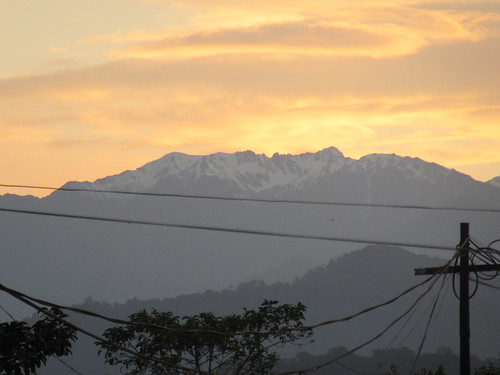 View of snow-topped mountains at sunset.
View of snow-topped mountains at sunset.
We walked back to Putao Trekking House who, at my request, had produced non-spicy food for my dinner, so I was able to enjoy my meal in the spacious restaurant with the Local Guide and Aung. Although I enjoy steamed rice, I can eat less than half of what my companions regarded as adequate. By this time, I was ready for bed. The local electricity supply goes off at about 9 o’clock in the evening (rooms were provided with re-chargeable lamps featuring a rectangular array of light emitting diodes to provide illumination when there's no mains) so I made myself comfortable in the bed and enjoyed an excellent night’s sleep.
Go to next post.
All my posts on this trip to Myanmar can be found here.
My pictures
By air from Yangon to Putao.
Putao Airport.
Putao.
Putao Trekking House.
[Text and pictures added 23rd Jun 2015]
On this trip, I visited the northernmost state of the Union of Myanmar, Katchin State, spending four days in and around Putoao. Wikipedia gives a simple introduction to Katchin State here.
Events of Tuesday 28th April 2015
I was picked up from Dr. Hla Tun’s house at around 09:15. In the car was the lady managing director of Sunbird Tours, Tin Htar Oo and my guide for the trip to Putao, Ye Aung Zaw (called simply 'Aung'). We set off into Yangon's heavy traffic. On the way to the airport, we dropped off Tin Htar Oo then carried on and arrived at Mingalardon’s bustling Domestic Terminal around 10:00, in plenty of time for the 11:30 Air Bagan flight to Putao. There’s very little in the way of automation and plenty of consultation of paper lists but our checked-in bags were accepted after weighing on old-fashioned weigh scales and on completion, we were issued with a little stick-on label which all the airlines use. Our Air Bagan labels had been marked in felt-tip pen ‘PBO’ (the ticketing code for Putao). We waited patiently in the departure hall until the public address system announced a one hour delay to our flight so we decided to go upstairs where there’s a reasonable buffet. We each had a leisurely soft drink and then went downstairs again but the information screen didn’t even mention our departure. Things looked more ominous when a couple of Air Bagan people came round with trays holding plastic cups of soft drinks and distributed small lunch boxes containing a cheese sandwich. I was somewhat mollified by the refreshment and then another announcement said that the delay would be one and a half hours – if true, better than I had feared.
 The Domestic Departure Hall at Mingalardon Airport, Yangon.
The Domestic Departure Hall at Mingalardon Airport, Yangon.
They were telling the truth – a ‘bell-boy’ carrying a board with the flight number circulated the waiting area announcing that the flight was ready for boarding about 90 minutes after we’d originally expected the call. We were loaded into one of the modern, air-conditioned transfer buses (I was rather sorry when they replaced the ancient ‘rattletraps’) and we drove off into the ‘International’ area of the apron, which initially puzzled me. But this was only to turn the bus around, after which we headed to a remote stand in the domestic area where an ATR42-series turbo-prop was waiting. When the doors of the transfer bus opened, I was hit by a wall of heat which took my breath away. Air Bagan were aware of the temperature and had provided a line of ground staff with umbrellas to shade the passengers walking the few yards from the bus to the rear airstairs on the aircraft. When the inevitable hold-up occurred as people found the correct seats, staff held the remaining passengers on the bus until the blockage had cleared.
 Umbrellas shaded passengers between the transfer bus and the aircraft, whilst technical ground staff sheltered under the wing.
Umbrellas shaded passengers between the transfer bus and the aircraft, whilst technical ground staff sheltered under the wing.
Soon we were airborne and heading for Mandalay at a cruising level of 19,000 feet. Air Bagan provided a simple but enjoyable lunchbox, a soft drink in a plastic cup and a tea or coffee before we landed at Mandalay on the longest runway in south-east Asia.
 Taxiing to a halt at Mandalasy International Airport.
Taxiing to a halt at Mandalasy International Airport.
We stayed in our seats whilst a transfer bus took away the 'leavers', returning with the 'joiners' a few minutes later. Before long, we were on our way to our second stop, Myitkyina, the capital of Katchin State. A new terminal building was being built next to the existing modest facilities.
 Myitkyina Airport: There appears to be lots of luggage to be loaded for the final leg.
Myitkyina Airport: There appears to be lots of luggage to be loaded for the final leg.
Once landed at Myitkyina, a lot of passengers left us but they were quickly replaced by passengers bound for Putao so we were full again for the last short leg to Putao.
As we approached Putao, mountains appeared on our left as a reminder that we are quite near Nepal but the airfield itself is located on a plateau (elevation 451 metres, I'm told). A crowd of people were standing outside the small terminal building - presumably passengers for the return ‘leg’.
 Putao Airport
Putao Airport
Rather than enter the terminal, we were directed to our left along an unsurfaced track, through a security check and into a large wooden barn with an immigration desk on the left where our local guide and tour leader Ngwa Phu Sar joined us as both my passport and my letter of introduction to Myanmar Immigration were carefully scrutinised.
 The Immigration Desk, Putao Airport.
The Immigration Desk, Putao Airport.
I noticed four basic check-in desks, one for each of the internal airlines serving Putao, and a single set of mechanical baggage scales which all the airlines share. After a few minutes, a group of baggage handlers appeared, struggling to get two loaded baggage trucks across the unsurfaced track. I quickly identified my bag and, after the baggage tag was checked against our receipt, we moved through a simple gate to an area full of three-wheeled bicycle taxis and a single Toyota SUV which was for us.
 The public parking area at Putao airport.
The public parking area at Putao airport.
On the road from the airport to Putao itself, we passed a number of quite large wooden family houses then we crossed a couple of large streams on ‘Bailey’ bridges (there's an description of 'Bailey' bridges in Wikipedia here), finally turning left off the road leading to the town centre up a short, steep hill to stop at Putao Trekking House. It appeared that most of the staff were waiting to greet us. Cold towels and a ‘Welcome’ drink of grapefruit juice were provided. The grounds were attractively landscaped with a large main building to our right and a number of ‘cottages’ on our left, each with two ground floor rooms and two rooms on an upper storey. I was impressed by my ground floor room, provided with a large double bed (decorated with fresh flower heads and with a mosquito net above), writing desk and storage facilities. A second tiled room was fitted with a wash handbasin, European-style W.C. and shower.
 My comfortable bed at Putao Trekking House.
My comfortable bed at Putao Trekking House.
After ‘freshening up’, I accepted the offer of a conducted tour on foot around the town centre with the Tour Leader and Aung. We passed the main open-air market but as it was late afternoon this was closed. We looked at schools, municipal buildings and shops, tea-shops and restaurants. As the sky darkened, I managed an ‘arty’ shot of the distant snow-covered mountains (slightly marred by the overhead electric wires in the foreground).
 View of snow-topped mountains at sunset.
View of snow-topped mountains at sunset.
We walked back to Putao Trekking House who, at my request, had produced non-spicy food for my dinner, so I was able to enjoy my meal in the spacious restaurant with the Local Guide and Aung. Although I enjoy steamed rice, I can eat less than half of what my companions regarded as adequate. By this time, I was ready for bed. The local electricity supply goes off at about 9 o’clock in the evening (rooms were provided with re-chargeable lamps featuring a rectangular array of light emitting diodes to provide illumination when there's no mains) so I made myself comfortable in the bed and enjoyed an excellent night’s sleep.
Go to next post.
All my posts on this trip to Myanmar can be found here.
My pictures
By air from Yangon to Putao.
Putao Airport.
Putao.
Putao Trekking House.
[Text and pictures added 23rd Jun 2015]
Tuesday, 28 April 2015
Visit to Bagan Schools, 2015
In earlier posts on this trip, I described my impressions of the Bagan Medical Clinic over three days (Friday, Saturday, Sunday).
The next day, Monday, the clinic was closed but the Doctor had arranged that, before flying back to Yangon, we would visit two of the schools supported by the RTM Social Contribution in the Bagan area. The two newly-qualified doctors accompanied us but, unfortunately, Emily's travel arrangements meant that she would not be able to see the schools.
Monday 27th April 2015
I took breakfast at my hotel in the open air restaurant, looking out across the river and then checked-out.
 View across the Ayeyarwaddy River from the Bagan Thiripyitsaya Sanctuary Resort.
View across the Ayeyarwaddy River from the Bagan Thiripyitsaya Sanctuary Resort.
As arranged, I was collected from my hotel at 07:50 and taken to the monastery. The Clinic was strangely quiet on a non-opening day but, as usual, I was offered another breakfast at the monastery. I accepted congee (a rather watery 'rice pudding' flavoured with salt) and then one of Dr. Hla Tun's assistants had brought in a home-made vegetable soup for me to try. It was good.
Unusually, the Head Monk was not present but, as we were finishing breakfast, he appeared and summoned Dr. Hla Tun and I to the monastic school building I'd not been in before. A prize-giving ceremony was already in full-swing and the head monk resumed his elaborately-carved chair at one end of the assembly room, flanked on either side by two monks, each seated on carved chairs. The room was crowded with schoolchildren and their parents.
 Prize-giving at the monastic school.
Prize-giving at the monastic school.
Having completed their examinations, this was the annual prize-giving. I've mentioned before the Myanmar has not succumbed to the "all must have prizes" syndrome which afflicts the United Kingdom. Children are respectful, disciplined and expect to work hard if they are to succeed. Each prizewinner was being presented with a framed, coloured certificate and a gift, the audience would applaud and what appeared to be an 'official photographer' would record the scene. Dr. Hla Tun made one presentation then I was instructed to make the next presentation. The Doctor and I were only there for a few minutes so I couldn't observe too much but I felt privileged to have seen the scene.
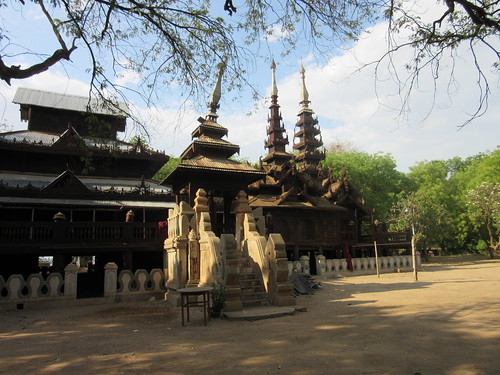 The oldest monastery building is mainly wooden and heavily decorated.
The oldest monastery building is mainly wooden and heavily decorated.
The monastery 'people carrier' was being packed with stationery which we were to distribute that morning. This Toyota vehicle was equipped with a wheelchair lift at the rear and a sign in the front window indicating that we were engaged on monastery-sponsored work. I noticed that, at the the main road toll station leaving Bagan, the road toll was waived. Monks are held in high regard in Myanmar.
We left the monastery and made the short drive to the 'Hotel @ Tharabar Gate' (yes, they use the ampersand, presumably to indicate how with-it they are). Here, we collected the newly-qualified doctor from Myanmar and her parents, together with her Chinese-American doctor friend. Our route then took us past the Ananda Temple onto the dual carriageway which, somewhat improbably, heads across the Bagan Plain, with pagodas all around.
At Nyaung Oo we took the dual carriageway out of town and I noticed 'kerb painters' at work. On dual carriageways, the right-hand kerb (remember, they now drive on the right) is painted white but the left-hand kerb is painted alternately red then white. Groups of male and female workers were quatting in the gutter (ignoring passing traffic) each with a pot of paint and a brush re-painting the kerbs. One group had white paint and, in a couple of hundred yards, the next group would have red paint and so on. When we returned in the afternoon, the work was still being done.
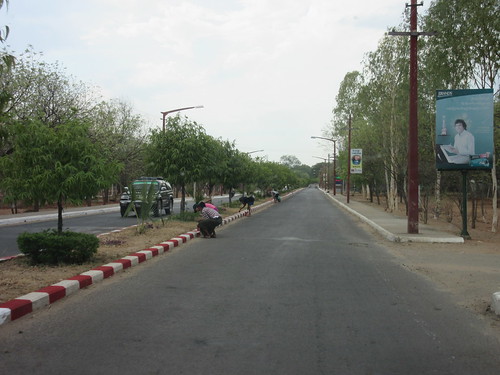 'Kerb painters' at work on the dual-carriageway leaving Nyaung Oo.
'Kerb painters' at work on the dual-carriageway leaving Nyaung Oo.
The changes taking place in Myanmar are very visible in this area - various construction projects are in hand: hotels and apartments (I think). Once we'd passed the airport and railway station turns, the road became single carriageway but still with a decent 'tarmac' surface' apart from the section across the currently-dry river bed. We passed a number of filling stations which are either new or still being completed. Eventually we passed into the sandy plain filled with Toddy Palms and, dotted around, the simple bamboo houses equipped with a still for producing the rum-like 'Toddy'.
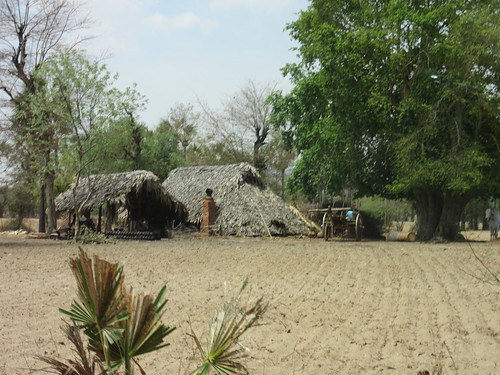 The short, brick chimney on the simple bamboo house indicates a still.
The short, brick chimney on the simple bamboo house indicates a still.
I wrote a brief description of 'toddy' in a 2009 post here (with a link to a few photographs).
We turned off the tarmac road onto the sandy track which, after around two miles of careful driving, took us to Chauk Kan.
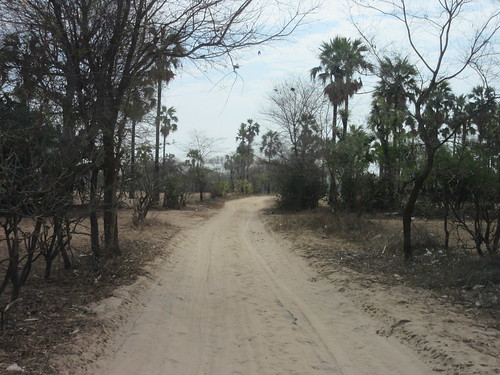 The sandy track to Chauk Kan village.
The sandy track to Chauk Kan village.
Chauk Kan
This was my fourth visit to the school here (my last visit is described in Visiting Bagan Schools and that post has links to the earlier visits).
Although the school was currently closed for the summer holiday, the assembly hall was full of excited pupils, anxious to receive their distribution of free stationery.
 Excited but well-behaved pupils in the assembly hall.
Excited but well-behaved pupils in the assembly hall.
The headmaster first offered us refreshments, then we joined the pupils in the assembly hall and ten girl dancers entertained us, accompanied by 'pop' music from a sound system. In the meantime, the stationery had been set up out of doors for distribution.
 Pupils queuing to receive stationery.
Pupils queuing to receive stationery.
The doctor had also brought a selection of spectacles allowing local elderly people to each select a suitable pair.
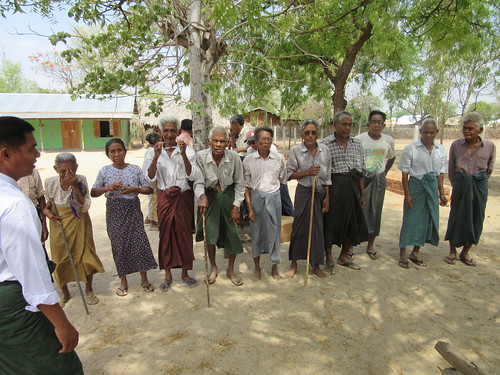 Villagers pose with their new spectacles.
Villagers pose with their new spectacles.
After the visitors had been shown around the school buildings, we returned to our car and retraced our route back to the main road, where we continued to Htee Pu. The village is reached by another long, sandy track which diverges from the tarmac road to Mount Popa at a junction marked by a concrete signpost.
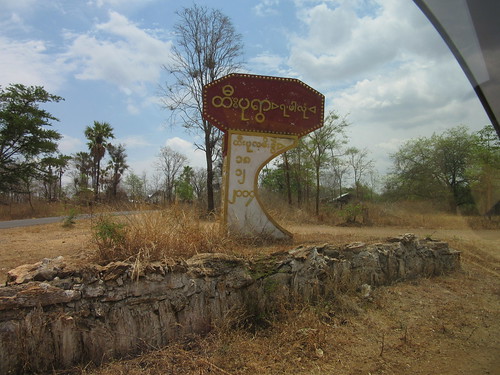 Concrete signpost at the junction with the road to Mount Popa.
Concrete signpost at the junction with the road to Mount Popa.
Htee Pu
Htee Pu was the first school I visited in the Bagan area, back in 2009. Since then, I've returned in 2010 (when a new, donated school building was opened), 2011 and 2012. In 2013, I visited schools at Nga-Minn-May and Chauk-Kan but time did not permit a visit to Htee Pu. But I visited in 2014 and, as described below, 2015.
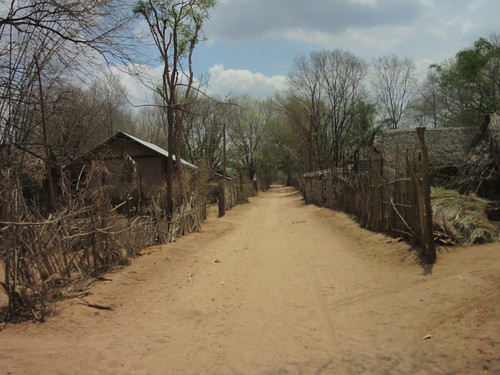 Part of Htee Pu village.
Part of Htee Pu village.
We drove into the monastery compound and parked near the main monastery building. The head monk greeted us and explained that the headmaster was away on a training course since the school was closed for the summer holiday. The visitors were each presented with flowers in welcome.
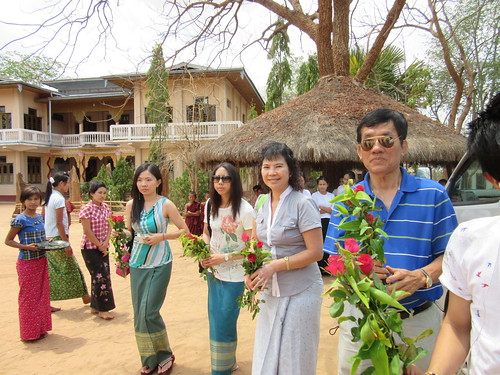 The Myanmar doctor, her parents and the Chinese-American doctor, presented with flowers.
The Myanmar doctor, her parents and the Chinese-American doctor, presented with flowers.
A large, colourful, bamboo-framed temporary shelter had been erected in the monastery compound and, school holidays or not, it was packed with waiting children, a group of lady teachers and villagers. The children were seated on the ground but a number of moulded plastic chairs had been provided for the visitors and some of the elderly villagers. A wooden stage covered with matting had been erected across one end, flanked on either side by serious-looking loudspeakers mounted on oildrums. Our visit was clearly being marked by a concert. Once the visitors were seated, we were treated to a variety of dances by different groups of children.
 The audience was torn between watching the dance and their exotic visitors.
The audience was torn between watching the dance and their exotic visitors.
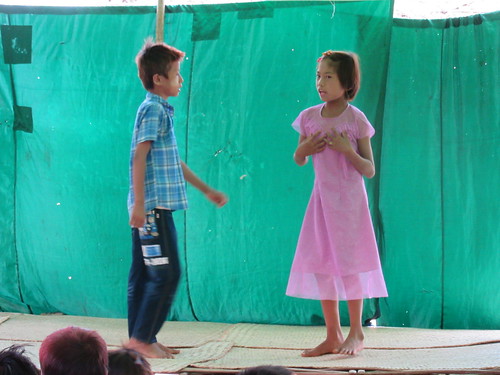 A boy-and-girl dance, with lots of actions.
A boy-and-girl dance, with lots of actions.
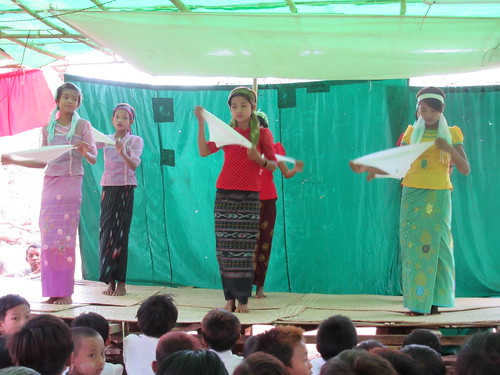 A dance with handkerchiefs.
A dance with handkerchiefs.
 Younger children performing.
Younger children performing.
During the more energetic dances, we worried about the strength of the stage but all was well. Everybody then turned to face the visitors and there were brief speeches from the Head Monk and Dr. Hla Tun during which the visitors were introduced to the audience.
A short video of part of the performance is available here. After seeing the video, the 'Back Button' will return you to this post.
A series of tables was then set up in the compound and the stationery we'd brought was set out. Helped by the lady teachers, each of the visitors distributed the stationery to the children.
 Jan distributing stationery to a group of young monks.
Jan distributing stationery to a group of young monks.
As at Chauk Kan, spectacles were available and there was a flurry of activity as the appropriate prescriptions were selected.
 Spectacle selection.
Spectacle selection.
The visitors were then taken on a conducted tour of the facilities, after which there was a group photograph of visitors and lady teachers outside the building opened in 2010.
 Visitors and teachers outside the building opened in 2010.
Visitors and teachers outside the building opened in 2010.
The elderly villagers then posed for the cameras with their new spectacles.
 Elderly villagers from Htee Pu.
Elderly villagers from Htee Pu.
We were then invited to the monastery for for a snack before we left.
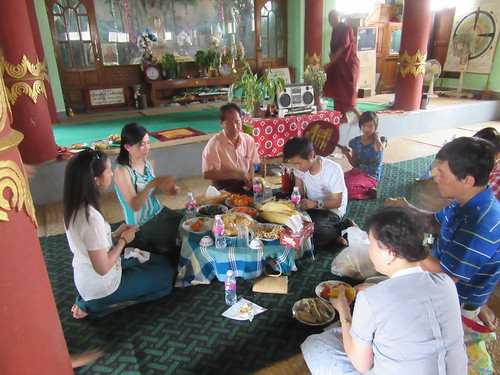 A snack in the monastery.
A snack in the monastery.
Mount Popa
The Doctor decided that there was time to show his visitors the area around Mount Popa. Mount Popa, an extinct volcano, is a special place for the Burmese. Adjacent is the rock pinnacle of Taung Kalat, topped by a number of temples. My first visit was in 2009, described here. I was so impressed, I returned in 2011 and stayed at the Mount Popa Resort. That visit is described here and here.
Arriving at the town, we stopped at what appears to be a privately-developed 'Taung Kalat Viewpoint'. This attraction is still under construction and it was interesting to see the numerous concrete religious statues in various stages of completion. Having taken pictures of the rock pinnacle of Taung Kalat, nobody seemed keen to climb it. Instead, we went to a well-appointed restaurant and took a very pleasant lunch.

Taung Kalat, from the Viewpoint.
We drove back to Bagan, returning four people to the 'Hotel @ Tharabar Gate' before driving to the Bagan Monastery, collecting our luggage and saying our goodbyes. We were then driven to Bagan Airport to check in for the Air Bagan flight to Yangon. The flight, operated by Air Bagan's hardworking ATR72 (registration XY-AIH) was on time. Back at Yangon, we drove to the Doctor's house where I was to spend a final night.
 Air Bagan's ATR72 XY-AIH on arrival at Bagan.
Air Bagan's ATR72 XY-AIH on arrival at Bagan.
The following morning, the next 'segment' of my trip was to start with a flight to Putao, in the far north of Myanmar.
Go to next post on this trip.
All my posts describing this trip to Myanmar can be found here.
Previous Posts describing my visits to Htee Pu
2009.
2010.
2011.
2012.
2014.
My pictures
The following albums (on Flickr) hold pictures relevant to this post:-
Bagan Monastery and Prize-giving Ceremony.
Around Bagan, 2015.
Visit to Chauk Kan, 2015.
Visit to Htee Pu, 2015.
Around Mount Popa, 2015.
All my albums for this trip can be found here.
[Text and pictures added 17th, 22nd and 23rd June 2015, videos added 14th July 2015]
Monday 27th April 2015
I took breakfast at my hotel in the open air restaurant, looking out across the river and then checked-out.
 View across the Ayeyarwaddy River from the Bagan Thiripyitsaya Sanctuary Resort.
View across the Ayeyarwaddy River from the Bagan Thiripyitsaya Sanctuary Resort.
As arranged, I was collected from my hotel at 07:50 and taken to the monastery. The Clinic was strangely quiet on a non-opening day but, as usual, I was offered another breakfast at the monastery. I accepted congee (a rather watery 'rice pudding' flavoured with salt) and then one of Dr. Hla Tun's assistants had brought in a home-made vegetable soup for me to try. It was good.
Unusually, the Head Monk was not present but, as we were finishing breakfast, he appeared and summoned Dr. Hla Tun and I to the monastic school building I'd not been in before. A prize-giving ceremony was already in full-swing and the head monk resumed his elaborately-carved chair at one end of the assembly room, flanked on either side by two monks, each seated on carved chairs. The room was crowded with schoolchildren and their parents.
 Prize-giving at the monastic school.
Prize-giving at the monastic school.
Having completed their examinations, this was the annual prize-giving. I've mentioned before the Myanmar has not succumbed to the "all must have prizes" syndrome which afflicts the United Kingdom. Children are respectful, disciplined and expect to work hard if they are to succeed. Each prizewinner was being presented with a framed, coloured certificate and a gift, the audience would applaud and what appeared to be an 'official photographer' would record the scene. Dr. Hla Tun made one presentation then I was instructed to make the next presentation. The Doctor and I were only there for a few minutes so I couldn't observe too much but I felt privileged to have seen the scene.
 The oldest monastery building is mainly wooden and heavily decorated.
The oldest monastery building is mainly wooden and heavily decorated.
The monastery 'people carrier' was being packed with stationery which we were to distribute that morning. This Toyota vehicle was equipped with a wheelchair lift at the rear and a sign in the front window indicating that we were engaged on monastery-sponsored work. I noticed that, at the the main road toll station leaving Bagan, the road toll was waived. Monks are held in high regard in Myanmar.
We left the monastery and made the short drive to the 'Hotel @ Tharabar Gate' (yes, they use the ampersand, presumably to indicate how with-it they are). Here, we collected the newly-qualified doctor from Myanmar and her parents, together with her Chinese-American doctor friend. Our route then took us past the Ananda Temple onto the dual carriageway which, somewhat improbably, heads across the Bagan Plain, with pagodas all around.
At Nyaung Oo we took the dual carriageway out of town and I noticed 'kerb painters' at work. On dual carriageways, the right-hand kerb (remember, they now drive on the right) is painted white but the left-hand kerb is painted alternately red then white. Groups of male and female workers were quatting in the gutter (ignoring passing traffic) each with a pot of paint and a brush re-painting the kerbs. One group had white paint and, in a couple of hundred yards, the next group would have red paint and so on. When we returned in the afternoon, the work was still being done.
 'Kerb painters' at work on the dual-carriageway leaving Nyaung Oo.
'Kerb painters' at work on the dual-carriageway leaving Nyaung Oo.
The changes taking place in Myanmar are very visible in this area - various construction projects are in hand: hotels and apartments (I think). Once we'd passed the airport and railway station turns, the road became single carriageway but still with a decent 'tarmac' surface' apart from the section across the currently-dry river bed. We passed a number of filling stations which are either new or still being completed. Eventually we passed into the sandy plain filled with Toddy Palms and, dotted around, the simple bamboo houses equipped with a still for producing the rum-like 'Toddy'.
 The short, brick chimney on the simple bamboo house indicates a still.
The short, brick chimney on the simple bamboo house indicates a still.
I wrote a brief description of 'toddy' in a 2009 post here (with a link to a few photographs).
We turned off the tarmac road onto the sandy track which, after around two miles of careful driving, took us to Chauk Kan.
 The sandy track to Chauk Kan village.
The sandy track to Chauk Kan village.
Chauk Kan
This was my fourth visit to the school here (my last visit is described in Visiting Bagan Schools and that post has links to the earlier visits).
Although the school was currently closed for the summer holiday, the assembly hall was full of excited pupils, anxious to receive their distribution of free stationery.
 Excited but well-behaved pupils in the assembly hall.
Excited but well-behaved pupils in the assembly hall.
The headmaster first offered us refreshments, then we joined the pupils in the assembly hall and ten girl dancers entertained us, accompanied by 'pop' music from a sound system. In the meantime, the stationery had been set up out of doors for distribution.
 Pupils queuing to receive stationery.
Pupils queuing to receive stationery.
The doctor had also brought a selection of spectacles allowing local elderly people to each select a suitable pair.
 Villagers pose with their new spectacles.
Villagers pose with their new spectacles.
After the visitors had been shown around the school buildings, we returned to our car and retraced our route back to the main road, where we continued to Htee Pu. The village is reached by another long, sandy track which diverges from the tarmac road to Mount Popa at a junction marked by a concrete signpost.
 Concrete signpost at the junction with the road to Mount Popa.
Concrete signpost at the junction with the road to Mount Popa.
Htee Pu
Htee Pu was the first school I visited in the Bagan area, back in 2009. Since then, I've returned in 2010 (when a new, donated school building was opened), 2011 and 2012. In 2013, I visited schools at Nga-Minn-May and Chauk-Kan but time did not permit a visit to Htee Pu. But I visited in 2014 and, as described below, 2015.
 Part of Htee Pu village.
Part of Htee Pu village.
We drove into the monastery compound and parked near the main monastery building. The head monk greeted us and explained that the headmaster was away on a training course since the school was closed for the summer holiday. The visitors were each presented with flowers in welcome.
 The Myanmar doctor, her parents and the Chinese-American doctor, presented with flowers.
The Myanmar doctor, her parents and the Chinese-American doctor, presented with flowers.
A large, colourful, bamboo-framed temporary shelter had been erected in the monastery compound and, school holidays or not, it was packed with waiting children, a group of lady teachers and villagers. The children were seated on the ground but a number of moulded plastic chairs had been provided for the visitors and some of the elderly villagers. A wooden stage covered with matting had been erected across one end, flanked on either side by serious-looking loudspeakers mounted on oildrums. Our visit was clearly being marked by a concert. Once the visitors were seated, we were treated to a variety of dances by different groups of children.
 The audience was torn between watching the dance and their exotic visitors.
The audience was torn between watching the dance and their exotic visitors.
 A boy-and-girl dance, with lots of actions.
A boy-and-girl dance, with lots of actions.
 A dance with handkerchiefs.
A dance with handkerchiefs.
 Younger children performing.
Younger children performing.
During the more energetic dances, we worried about the strength of the stage but all was well. Everybody then turned to face the visitors and there were brief speeches from the Head Monk and Dr. Hla Tun during which the visitors were introduced to the audience.
A short video of part of the performance is available here. After seeing the video, the 'Back Button' will return you to this post.
A series of tables was then set up in the compound and the stationery we'd brought was set out. Helped by the lady teachers, each of the visitors distributed the stationery to the children.
 Jan distributing stationery to a group of young monks.
Jan distributing stationery to a group of young monks.
As at Chauk Kan, spectacles were available and there was a flurry of activity as the appropriate prescriptions were selected.
 Spectacle selection.
Spectacle selection.
The visitors were then taken on a conducted tour of the facilities, after which there was a group photograph of visitors and lady teachers outside the building opened in 2010.
 Visitors and teachers outside the building opened in 2010.
Visitors and teachers outside the building opened in 2010.
The elderly villagers then posed for the cameras with their new spectacles.
 Elderly villagers from Htee Pu.
Elderly villagers from Htee Pu.
We were then invited to the monastery for for a snack before we left.
 A snack in the monastery.
A snack in the monastery.
Mount Popa
The Doctor decided that there was time to show his visitors the area around Mount Popa. Mount Popa, an extinct volcano, is a special place for the Burmese. Adjacent is the rock pinnacle of Taung Kalat, topped by a number of temples. My first visit was in 2009, described here. I was so impressed, I returned in 2011 and stayed at the Mount Popa Resort. That visit is described here and here.
Arriving at the town, we stopped at what appears to be a privately-developed 'Taung Kalat Viewpoint'. This attraction is still under construction and it was interesting to see the numerous concrete religious statues in various stages of completion. Having taken pictures of the rock pinnacle of Taung Kalat, nobody seemed keen to climb it. Instead, we went to a well-appointed restaurant and took a very pleasant lunch.

Taung Kalat, from the Viewpoint.
We drove back to Bagan, returning four people to the 'Hotel @ Tharabar Gate' before driving to the Bagan Monastery, collecting our luggage and saying our goodbyes. We were then driven to Bagan Airport to check in for the Air Bagan flight to Yangon. The flight, operated by Air Bagan's hardworking ATR72 (registration XY-AIH) was on time. Back at Yangon, we drove to the Doctor's house where I was to spend a final night.
 Air Bagan's ATR72 XY-AIH on arrival at Bagan.
Air Bagan's ATR72 XY-AIH on arrival at Bagan.
The following morning, the next 'segment' of my trip was to start with a flight to Putao, in the far north of Myanmar.
Go to next post on this trip.
All my posts describing this trip to Myanmar can be found here.
Previous Posts describing my visits to Htee Pu
2009.
2010.
2011.
2012.
2014.
My pictures
The following albums (on Flickr) hold pictures relevant to this post:-
Bagan Monastery and Prize-giving Ceremony.
Around Bagan, 2015.
Visit to Chauk Kan, 2015.
Visit to Htee Pu, 2015.
Around Mount Popa, 2015.
All my albums for this trip can be found here.
[Text and pictures added 17th, 22nd and 23rd June 2015, videos added 14th July 2015]
Sunday, 26 April 2015
A Weekend at Bagan Medical Clinic (Part 3)
Bagan Medical Clinic opens on Friday, Saturday and Sunday each week. On my trip to Myanmar in 2015, I was travelling with the founder and senior clinician Doctor Hla Tun, so I was able to get a non-medical impression of the activities over a complete three-day "Weekend".
In Part 1, I briefly described the Clinic and the activities on Friday 24th April 2015.
In Part 2, I described what I saw on Saturday 25th April 2015.
It might be worth pointing out some of the differences between Burmese and Western cultures. Some readers will be surprised that I have been able to publish pictures of patients receiving treatment. What about patient confidentiality? What about personal privacy? I was appalled myself at first, but these concepts don't seem to exist as Westerners might understand them in Myanmar (and, indeed, many other countries). Secondly, when charitable donations are made, they are frequently recorded in photographs. Even if photographs are not made, contributions may be otherwise recorded. For instance, many pagodas display a list of recent donations and buildings which have been donated frequently carry marble tablets naming the donor.
Sunday 26th April 2015
Once again, Emily and I were picked up around 08:00 by car and taken to the Clinic. On arrival, we discovered that, despite Dr. Hla Tun and his staff working until 02:10 on Sunday morning, 28 patients from his Saturday list had been 'held over' and he started seeing them at about 09:00. In addition, about 200 more patients had registered. Since Sunday is the last day of the 3-day clinic opening each week, it's not possible to 'carry over' untreated patients and so the Doctor may 'close' his list earlier on Sunday to ensure that everyone is seen.
The newly-qualified doctors mentioned in Part 2 once again practiced their diagnostic skills on Sunday.
 The 'group shot'.
The 'group shot'.
The cases which Dr. Hla Tun deals with frequently involve various simultaneous problems. Poverty often leads to poor diet and the body's immune system becomes weakened and less able to deal with diseases. Mobility problems are widespread and joint pains can prevent people from working and earning a living. As appropriate, different strategies are used by Doctor Hla Tun but aspirating fluid from joints followed by various injections for pain relief and to improve the body's immunity is a common approach. Sometimes dietary supplements in powder form are provided for the patient to take. In more serious cases, an infusion of amino acids may be made at the clinic. The rigours of travelling long distances in Myanmar to reach the Bagan Clinic may add to the problems.
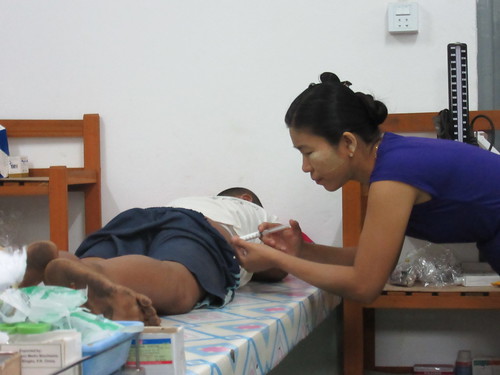 A patient receiving an intra-muscular injection.
A patient receiving an intra-muscular injection.
Lunch
The physical well-being of waiting patients is taken very seriously and there are various dormitories which can be used by waiting patients plus toilets with washing facilities. On each clinic day, a hot lunch is provided for waiting patients and accompanying relatives at around 11:30. During the morning, a number of monastery people had been involved in the preparation of those meals.

The Head Monk overseeing vegetable preparation for the patient lunches.
At about 11:30 a queue of waiting patients formed and, as usual, the Head Monk started the distribution himself but, on Sunday, he then invited me to take over and, within a few minutes, around 220 meals had been distributed. The business of making an offering has great cultural significance in Myanmar, with its Buddhist traditions. On some clinic days, an evening meal is provided as well.
 Distribution of hot lunches.
Distribution of hot lunches.
After the patient lunches, the Doctor continued consultations until about 13:30, then there was a break, allowing some of the medical staff to take lunch in the monastery, as on previous days.
Additional Tests
From time to time during the day, Dr. Hla Tun referred patients to the laboratory for specific tests on blood/urine or for E.C.G. tests. Remarkably quickly, patients would return, clutching the completed results sheet or the E.C.G. plot. The benefits of these in-house facilities are enormous, in facilitating timely confirmation of a diagnosis. It is not practical to recall patients, many of whom have travelled long distances to the clinic, so treatment must be completed in a single visit.
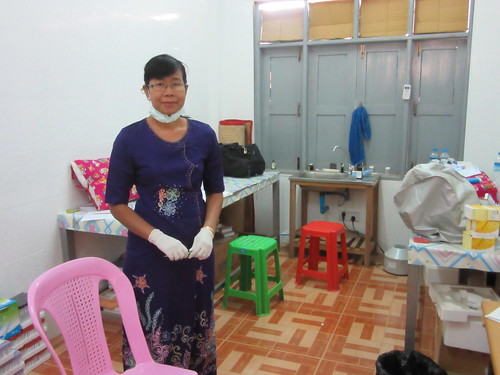 The laboratory technician and well-equipped laboratory.
The laboratory technician and well-equipped laboratory.
The Afternoon Clinic
The afternoon clinic continued in a similar manner with a lot of help given to improve mobility and various other problems.

A patient receives an injection.
A woman from Mandalay suffering from cirrhosis of the liver had been treated in the morning and given an infusion of amino acids. She had travelled with her mother by train from Mandalay (fairly cheap but not a journey to undertake lightly). She seemed little improved in the afternoon but the Bagan Clinic could not provide further treatment so the Doctor made a cash donation towards hospitalisation and transportation costs.
 Dr. Hla Tun giving a donation towards cost of hospitalisation.
Dr. Hla Tun giving a donation towards cost of hospitalisation.
I'm afraid I left the Doctor at 16:30 and returned to the comfort of my hotel - the Bagan Thiripyitsaya Sanctuary Resort.
Next?
The plan for the following day was to re-visit two schools in the Bagan area with Doctor Hla Tun. These schools are supported by the RTM Social Contribution. Later in the afternoon, we were due to fly back to Yangon.
Go to next post on this trip.
All my posts on the Bagan Medical Clinic can be found here.
All my posts describing this trip to Myanmar can be found here.
My pictures
The internet in the Bagan area seemed much improved, but was not suitable for uploading all my pictures. I finally made them available after my return to England. The following albums (on Flickr) are relevant to this post:-
Bagan Clinic, Sunday, 26th April 2015.
Bagan Thiripyitsaya Sanctuary Resort.
All my albums for this trip can be found here.
[Text amended, pictures added 11th June 2015]
In Part 1, I briefly described the Clinic and the activities on Friday 24th April 2015.
In Part 2, I described what I saw on Saturday 25th April 2015.
It might be worth pointing out some of the differences between Burmese and Western cultures. Some readers will be surprised that I have been able to publish pictures of patients receiving treatment. What about patient confidentiality? What about personal privacy? I was appalled myself at first, but these concepts don't seem to exist as Westerners might understand them in Myanmar (and, indeed, many other countries). Secondly, when charitable donations are made, they are frequently recorded in photographs. Even if photographs are not made, contributions may be otherwise recorded. For instance, many pagodas display a list of recent donations and buildings which have been donated frequently carry marble tablets naming the donor.
Sunday 26th April 2015
Once again, Emily and I were picked up around 08:00 by car and taken to the Clinic. On arrival, we discovered that, despite Dr. Hla Tun and his staff working until 02:10 on Sunday morning, 28 patients from his Saturday list had been 'held over' and he started seeing them at about 09:00. In addition, about 200 more patients had registered. Since Sunday is the last day of the 3-day clinic opening each week, it's not possible to 'carry over' untreated patients and so the Doctor may 'close' his list earlier on Sunday to ensure that everyone is seen.
The newly-qualified doctors mentioned in Part 2 once again practiced their diagnostic skills on Sunday.
 The 'group shot'.
The 'group shot'.
The cases which Dr. Hla Tun deals with frequently involve various simultaneous problems. Poverty often leads to poor diet and the body's immune system becomes weakened and less able to deal with diseases. Mobility problems are widespread and joint pains can prevent people from working and earning a living. As appropriate, different strategies are used by Doctor Hla Tun but aspirating fluid from joints followed by various injections for pain relief and to improve the body's immunity is a common approach. Sometimes dietary supplements in powder form are provided for the patient to take. In more serious cases, an infusion of amino acids may be made at the clinic. The rigours of travelling long distances in Myanmar to reach the Bagan Clinic may add to the problems.
 A patient receiving an intra-muscular injection.
A patient receiving an intra-muscular injection.
Lunch
The physical well-being of waiting patients is taken very seriously and there are various dormitories which can be used by waiting patients plus toilets with washing facilities. On each clinic day, a hot lunch is provided for waiting patients and accompanying relatives at around 11:30. During the morning, a number of monastery people had been involved in the preparation of those meals.

The Head Monk overseeing vegetable preparation for the patient lunches.
At about 11:30 a queue of waiting patients formed and, as usual, the Head Monk started the distribution himself but, on Sunday, he then invited me to take over and, within a few minutes, around 220 meals had been distributed. The business of making an offering has great cultural significance in Myanmar, with its Buddhist traditions. On some clinic days, an evening meal is provided as well.
 Distribution of hot lunches.
Distribution of hot lunches.
After the patient lunches, the Doctor continued consultations until about 13:30, then there was a break, allowing some of the medical staff to take lunch in the monastery, as on previous days.
Additional Tests
From time to time during the day, Dr. Hla Tun referred patients to the laboratory for specific tests on blood/urine or for E.C.G. tests. Remarkably quickly, patients would return, clutching the completed results sheet or the E.C.G. plot. The benefits of these in-house facilities are enormous, in facilitating timely confirmation of a diagnosis. It is not practical to recall patients, many of whom have travelled long distances to the clinic, so treatment must be completed in a single visit.
 The laboratory technician and well-equipped laboratory.
The laboratory technician and well-equipped laboratory.
The Afternoon Clinic
The afternoon clinic continued in a similar manner with a lot of help given to improve mobility and various other problems.

A patient receives an injection.
A woman from Mandalay suffering from cirrhosis of the liver had been treated in the morning and given an infusion of amino acids. She had travelled with her mother by train from Mandalay (fairly cheap but not a journey to undertake lightly). She seemed little improved in the afternoon but the Bagan Clinic could not provide further treatment so the Doctor made a cash donation towards hospitalisation and transportation costs.
 Dr. Hla Tun giving a donation towards cost of hospitalisation.
Dr. Hla Tun giving a donation towards cost of hospitalisation.
I'm afraid I left the Doctor at 16:30 and returned to the comfort of my hotel - the Bagan Thiripyitsaya Sanctuary Resort.
Next?
The plan for the following day was to re-visit two schools in the Bagan area with Doctor Hla Tun. These schools are supported by the RTM Social Contribution. Later in the afternoon, we were due to fly back to Yangon.
Go to next post on this trip.
All my posts on the Bagan Medical Clinic can be found here.
All my posts describing this trip to Myanmar can be found here.
My pictures
The internet in the Bagan area seemed much improved, but was not suitable for uploading all my pictures. I finally made them available after my return to England. The following albums (on Flickr) are relevant to this post:-
Bagan Clinic, Sunday, 26th April 2015.
Bagan Thiripyitsaya Sanctuary Resort.
All my albums for this trip can be found here.
[Text amended, pictures added 11th June 2015]
Saturday, 25 April 2015
A Weekend at Bagan Medical Clinic (Part 2)
In Part 1, I briefly described the Clinic and the activities on Friday 24th April 2015.
Saturday 25th April 2015
After a good night's sleep at the Bagan Thiripyitsaya Sanctuary Resort, I took breakfast before exploring more of the hotel grounds. Adjacent to the hotel access road, I'd seen a restored temple and I examined this more carefully. A sign informed me that the site was the Kaladha Koun monastic complex, dating from the 13th century. Some parts remained only as ruined brick walls but the one temple had been restored. A marble tablet commemorated the completion of this work, sponsored by the hotel on 2nd May, 1998.
 The restored temple in the hotel grounds.
The restored temple in the hotel grounds.
A little after 08:00, a car arrived to pick me up. We drove to Emily's hotel to collect her and we were then taken to the Bagan Clinic. When we arrived, about 150 patients had registered but when I enquired later in the day, that number had already risen to 250 and the 'List' had not been closed so the final total for the day may have been higher.

Patient registration.
The newly-qualified Burmese doctor we'd met the previous day was joined by a newly-qualified Chinese-American Doctor and they were allowed to practice their diagnostic skills. Of course, this meant that Dr. Hla Tun was frequently interrupted to confirm the correct diagnosis and treatment.
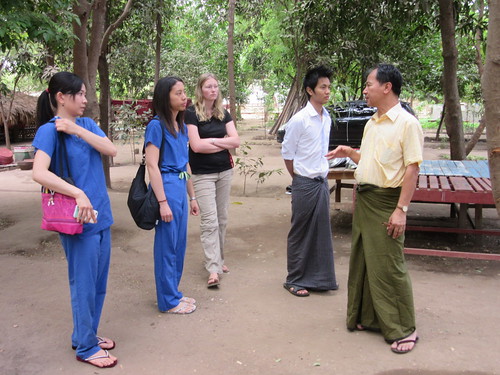 The two newly-qualified doctors (in blue 'scrubs') are briefed by Dr. Hla Tun.
The two newly-qualified doctors (in blue 'scrubs') are briefed by Dr. Hla Tun.
On initial registration, each new patient is issued with a record book with basic information. This is handed to the doctor giving treatment and completed to show the details of treatment. This book is then retained by the patient and, should further treatment be required, the record book is brought back by the patient when registering.
Dr. Hla Tun's Treatment Room
Dr. Hla Tun is assisted by two dedicated members of staff whom he has trained and give him high-quality support.
 Dr. Hla Tun's assistants.
Dr. Hla Tun's assistants.
The treatment room in which they work has three examination couches and various racks holding commonly-used items. A remarkable number of injections are required and the assistants will pre-prepare a small number of various injections to reduce the treatment time.
 Pre-prepared injections.
Pre-prepared injections.
When a patient is 'referred' to Doctor Hla Tun by one of the clinic doctors, the patient's record book is placed in order on a pile in the treatment room. As each patient's treatment is completed, Dr. Hla Tun writes up their record book which is returned to the patient. The next record book on the pile identifies the patient to be called in from the covered waiting area immediately outside the treatment room. This is done by one of the assistants who measures blood pressure and obtains details of the problem whilst Dr. Hla Tun is attending the patient on the third examination couch. There is thus no wasted time as one patient leaves and the next enters.
As necessary, Dr. Hla Hun will carry out checks with a stethescope, check the pulse and carry out simple diagnostic tests. He will ask the patient additional questions, and this occasionally brings problems. Because patients often travel long distances from other parts of Myanmar to reach the clinic, they may speak in an unfamiliar dialect with the possibilities for misunderstanding.
Additional Tests
Through the generosity of donors, it has been possible to add a well-equipped laboratory and various blood and urine tests are produced as required. An electro-cardiograph machine allows heart performance to be monitored and ultra-sound facilities are being added. A standard lab report form is completed by the Doctor indicating the required tests and the patient takes this to the laboratory, returning later with the results added to the same form by the technician.
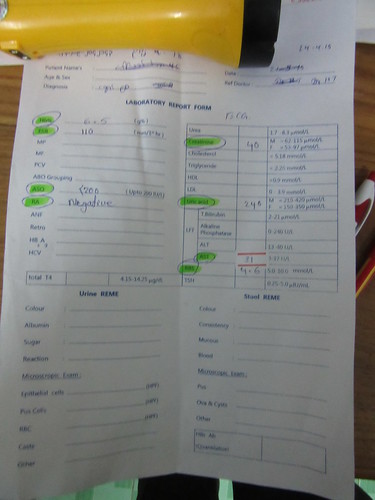
A completed lab report form.
Additional Facilities
Many patients display impaired mobility and joint pain from a variety of causes. The availability of a well-equipped physiotherapy unit at the clinic offers the possibility of helping patients to improve their situation.
 Treating knee problems.
Treating knee problems.
Lunch and beyond
Once again, the Doctor broke-off at 11:30 to show his visitors the distribution of the free lunch. This time, the Head Monk and Emily shared the handing out of the plates of food whilst I, with help from the jolly Monk who calls patients for their initial assessment, handed out the pressed metal spoons.
 Distribution of free lunch.
Distribution of free lunch.
The Doctor had hoped to break for his own lunch at about one o'clock but some tricky cases (one requiring an infusion) meant it was after 14:20 before his morning surgery was finished. Once again, we were treated to lunch in the monastery.
 Lunch in the monastery.
Lunch in the monastery.
At the start of Dr. Hla Tun's afternoon surgery, three patients were brought in initially but, thereafter, as one patient left, another was admitted whilst the doctor was treating one of the other two patients. Each patient may require a number of injections but if the injections are straightforward, they may be carried out by one of the Doctor's assistants. The aim is to reduce lost time so that, as far as practical, the doctor and his two assistants are each working with a different patient.
 Back treatment.
Back treatment.
Physical Records
Doctor Hla Tun has always insisted on comprehensive records. In addition to the patient's record book, written records are maintained at the clinic about treatments given. There is not a computer in sight but the Doctor can extract statistics in various ways. A surprising statistic is that, although the original concept was to provide health services to the Bagan area, now 90% of patients are from outside the Bagan area. Neither the Head Monk nor Dr. Hla Tun have any reservations about the involuntary expansion of services. They continue to aim to offer the best service possible.
I feel privileged to be able to report on this inspirational project but note that all errors are my own.
An Interlude
During the afternoon, I decided to explore the local area a little more. The monastery compound which houses the clinic is on a sandy cliff overlooking the Ayeyarwaddy River. Steep concrete-faced steps led down to the river, with a tablet acknowledging the donor:-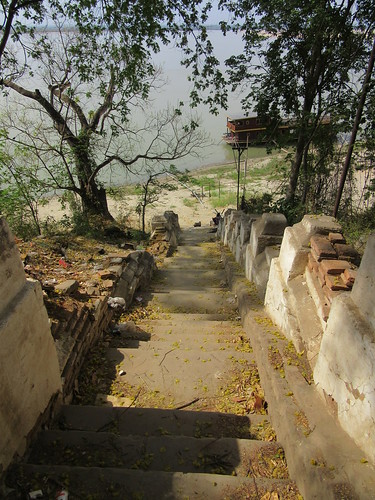
Steep steps leading to the river.
In a couple of places, electric pumps connected to long pipes were provided to lift water directly from the river to storage arrangements in the monastery compound.
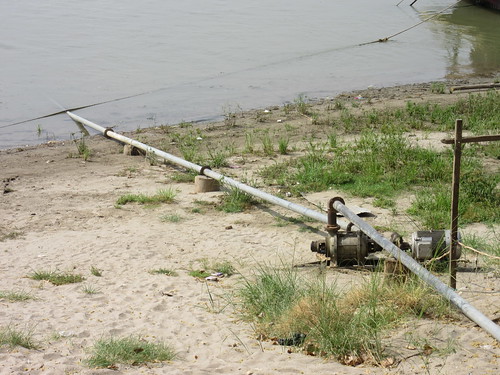 One of the electric pumps on the river bank.
One of the electric pumps on the river bank.
But my eye was drawn to a moored ship, probably little more than a hulk but with paddle boxes either side, conjuring visions of the 'Irrawaddy Flotilla' and Kipling's words "Can't you 'ear their paddles clunkin' from Rangoon to Mandalay?". There's more about Kipling's Burma and his famous poem here.
 "Can't you 'ear their paddles clunkin' from Rangoon to Mandalay?".
"Can't you 'ear their paddles clunkin' from Rangoon to Mandalay?".
Part of the fascination of the Bagan area is the sheer number of surviving pagodas - some large, some small, some in deteriorating condition, some carefully restored and built in differing architectural styles, according to their age. Within a few hundred yards of the Medical Clinic, I was able to explore a number of pagodas.
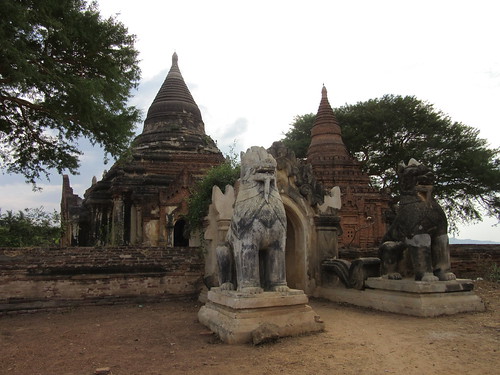 Pagodas protected by a pair of mythical Burmese lions (Chinthe).
Pagodas protected by a pair of mythical Burmese lions (Chinthe).

A pagoda in a different style.

Yet another style of pagoda.
Exhausted by my explorations, I returned to the Bagan Medical Clinic but, after observing treatments for a while, Emily and I were taken by car to our respective hotels for a relaxing evening. The next morning, we would have a chance to observe the final day of clinic opening for that week.
Go to next post on this trip.
All my posts on the Bagan Medical Clinic can be found here.
All my posts on this trip to Myanmar can be found here.
My pictures
The following albums (on Flickr) hold pictures relevant to this post:-
Bagan Clinic, Saturday 25th April 2015.
Bagan Thiripyitsaya Sanctuary Resort.
Around Bagan, 2015.
All my albums for this trip (except purely 'technical' ones) can be found here.
[Text revised, pictures added 10th and 22nd June 2015]
Saturday 25th April 2015
After a good night's sleep at the Bagan Thiripyitsaya Sanctuary Resort, I took breakfast before exploring more of the hotel grounds. Adjacent to the hotel access road, I'd seen a restored temple and I examined this more carefully. A sign informed me that the site was the Kaladha Koun monastic complex, dating from the 13th century. Some parts remained only as ruined brick walls but the one temple had been restored. A marble tablet commemorated the completion of this work, sponsored by the hotel on 2nd May, 1998.
 The restored temple in the hotel grounds.
The restored temple in the hotel grounds.
A little after 08:00, a car arrived to pick me up. We drove to Emily's hotel to collect her and we were then taken to the Bagan Clinic. When we arrived, about 150 patients had registered but when I enquired later in the day, that number had already risen to 250 and the 'List' had not been closed so the final total for the day may have been higher.

Patient registration.
The newly-qualified Burmese doctor we'd met the previous day was joined by a newly-qualified Chinese-American Doctor and they were allowed to practice their diagnostic skills. Of course, this meant that Dr. Hla Tun was frequently interrupted to confirm the correct diagnosis and treatment.
 The two newly-qualified doctors (in blue 'scrubs') are briefed by Dr. Hla Tun.
The two newly-qualified doctors (in blue 'scrubs') are briefed by Dr. Hla Tun.
On initial registration, each new patient is issued with a record book with basic information. This is handed to the doctor giving treatment and completed to show the details of treatment. This book is then retained by the patient and, should further treatment be required, the record book is brought back by the patient when registering.
Dr. Hla Tun's Treatment Room
Dr. Hla Tun is assisted by two dedicated members of staff whom he has trained and give him high-quality support.
 Dr. Hla Tun's assistants.
Dr. Hla Tun's assistants.
The treatment room in which they work has three examination couches and various racks holding commonly-used items. A remarkable number of injections are required and the assistants will pre-prepare a small number of various injections to reduce the treatment time.
 Pre-prepared injections.
Pre-prepared injections.
When a patient is 'referred' to Doctor Hla Tun by one of the clinic doctors, the patient's record book is placed in order on a pile in the treatment room. As each patient's treatment is completed, Dr. Hla Tun writes up their record book which is returned to the patient. The next record book on the pile identifies the patient to be called in from the covered waiting area immediately outside the treatment room. This is done by one of the assistants who measures blood pressure and obtains details of the problem whilst Dr. Hla Tun is attending the patient on the third examination couch. There is thus no wasted time as one patient leaves and the next enters.
As necessary, Dr. Hla Hun will carry out checks with a stethescope, check the pulse and carry out simple diagnostic tests. He will ask the patient additional questions, and this occasionally brings problems. Because patients often travel long distances from other parts of Myanmar to reach the clinic, they may speak in an unfamiliar dialect with the possibilities for misunderstanding.
Additional Tests
Through the generosity of donors, it has been possible to add a well-equipped laboratory and various blood and urine tests are produced as required. An electro-cardiograph machine allows heart performance to be monitored and ultra-sound facilities are being added. A standard lab report form is completed by the Doctor indicating the required tests and the patient takes this to the laboratory, returning later with the results added to the same form by the technician.

A completed lab report form.
Additional Facilities
Many patients display impaired mobility and joint pain from a variety of causes. The availability of a well-equipped physiotherapy unit at the clinic offers the possibility of helping patients to improve their situation.
 Treating knee problems.
Treating knee problems.
Lunch and beyond
Once again, the Doctor broke-off at 11:30 to show his visitors the distribution of the free lunch. This time, the Head Monk and Emily shared the handing out of the plates of food whilst I, with help from the jolly Monk who calls patients for their initial assessment, handed out the pressed metal spoons.
 Distribution of free lunch.
Distribution of free lunch.
The Doctor had hoped to break for his own lunch at about one o'clock but some tricky cases (one requiring an infusion) meant it was after 14:20 before his morning surgery was finished. Once again, we were treated to lunch in the monastery.
 Lunch in the monastery.
Lunch in the monastery.
At the start of Dr. Hla Tun's afternoon surgery, three patients were brought in initially but, thereafter, as one patient left, another was admitted whilst the doctor was treating one of the other two patients. Each patient may require a number of injections but if the injections are straightforward, they may be carried out by one of the Doctor's assistants. The aim is to reduce lost time so that, as far as practical, the doctor and his two assistants are each working with a different patient.
 Back treatment.
Back treatment.
Physical Records
Doctor Hla Tun has always insisted on comprehensive records. In addition to the patient's record book, written records are maintained at the clinic about treatments given. There is not a computer in sight but the Doctor can extract statistics in various ways. A surprising statistic is that, although the original concept was to provide health services to the Bagan area, now 90% of patients are from outside the Bagan area. Neither the Head Monk nor Dr. Hla Tun have any reservations about the involuntary expansion of services. They continue to aim to offer the best service possible.
I feel privileged to be able to report on this inspirational project but note that all errors are my own.
An Interlude
During the afternoon, I decided to explore the local area a little more. The monastery compound which houses the clinic is on a sandy cliff overlooking the Ayeyarwaddy River. Steep concrete-faced steps led down to the river, with a tablet acknowledging the donor:-
"The renovation of the stair case, its steps and railings is meant for the welfare and wholesomeness of the children at Taungbi Le Yar village and for the safety of staff who sail with the "Road to Mandalay" Supported by MICHAEL PERRY The Chef Road to Mandalay 1999 - 2003."

Steep steps leading to the river.
In a couple of places, electric pumps connected to long pipes were provided to lift water directly from the river to storage arrangements in the monastery compound.
 One of the electric pumps on the river bank.
One of the electric pumps on the river bank.
But my eye was drawn to a moored ship, probably little more than a hulk but with paddle boxes either side, conjuring visions of the 'Irrawaddy Flotilla' and Kipling's words "Can't you 'ear their paddles clunkin' from Rangoon to Mandalay?". There's more about Kipling's Burma and his famous poem here.
 "Can't you 'ear their paddles clunkin' from Rangoon to Mandalay?".
"Can't you 'ear their paddles clunkin' from Rangoon to Mandalay?".
Part of the fascination of the Bagan area is the sheer number of surviving pagodas - some large, some small, some in deteriorating condition, some carefully restored and built in differing architectural styles, according to their age. Within a few hundred yards of the Medical Clinic, I was able to explore a number of pagodas.
 Pagodas protected by a pair of mythical Burmese lions (Chinthe).
Pagodas protected by a pair of mythical Burmese lions (Chinthe).

A pagoda in a different style.

Yet another style of pagoda.
Exhausted by my explorations, I returned to the Bagan Medical Clinic but, after observing treatments for a while, Emily and I were taken by car to our respective hotels for a relaxing evening. The next morning, we would have a chance to observe the final day of clinic opening for that week.
Go to next post on this trip.
All my posts on the Bagan Medical Clinic can be found here.
All my posts on this trip to Myanmar can be found here.
My pictures
The following albums (on Flickr) hold pictures relevant to this post:-
Bagan Clinic, Saturday 25th April 2015.
Bagan Thiripyitsaya Sanctuary Resort.
Around Bagan, 2015.
All my albums for this trip (except purely 'technical' ones) can be found here.
[Text revised, pictures added 10th and 22nd June 2015]
Subscribe to:
Posts (Atom)
